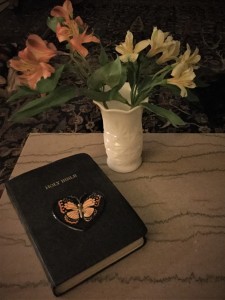Lectio Divina with Scripture
These times of pandemic challenge all of us. We seek hope, signposts for the journey, and sustenance to make it through. In this blog post I would like to encourage you to try the ancient practice of Lectio Divina. This practice will help you slow down and listen to sacred words that will shimmer into your life. You will find guidance and new inspiration to help you , make the most of these times.
Preliterate people told stories. Scripture of the ancient ones lived in their hearts before they became words on parchment and later paper. Later, common people who didn’t read relied on the spiritual leaders to read the holy words out loud. Words were carefully copied from one document to another. The monks were often the caretakers of the Christian scriptures in this way.
Over time, as more people learned to read, they began to read the scripture for themselves. The oral tradition, now written, helped them to learn about faith experiences in the past. Scriptures are read, discussed, dissected, researched and interpreted. A common practice in most Christian churches will be for a preacher to speak on various scriptures each Sunday. Bible studies help teach the scripture and the meanings, interpretations.
But back in the 6th century, Benedict of Nursia started a meditative approach to scripture. Instead of reading and studying the passages, he began to instruct the monks to also pray with the scripture. This approach, known as Lectio Divina, was formalized into a four-step process in the 12th century by a Carthusian monk, Guigo II. In later years, the Catholic Church recommended it as a way to read scripture. Although there are variations on the approach, the main goal is to read scripture slowly, listening for God’s word in a phrase or single word, rather than looking at the passage as a whole, in context.
You begin this practice by selecting a passage of scripture. Psalms work well. Usually, you begin by reading the scripture through once or twice out loud. This is the first step: Lectio (reading). During the readings, you listen for what “shimmers” or jumps out at you on this particular day. You allow the Spirit to call your attention to something. It could be a word, a sentence, a phrase.
After you have focused on a particular part of the scripture, you move into Meditatio (meditating), during which you reflect on the word or words deeply. What is the message for your life today? What are you hearing? What drew you to that word?
Once you have a sense of the message for you, move on to the third step of Oratio (praying). During this time, pray over whatever you’ve discovered here, and how this message speaks to your life. Pray for that thought to take root in your every day.
Finally, you end your prayer by sitting in silence during the Contemplativo (contemplating) step. Let your thoughts go and just be present to God. The Latin words used to describe these steps don’t quite jive with our understanding of the words. The contemplative step is actually what most of us now refer to as meditation. If you have a regular meditation practice, you can begin your practice with this divine reading approach as preparation, which is probably how the monks originally conceived of the process.
My own spiritual journey includes deepening meaning over time. I look for opportunities for new spiritual understanding. After years of reading scripture, there are many passages I have read and heard discussed hundreds of times. It’s so important for me to have ways to keep the scripture fresh for me. Lectio Divina provides a great way for me to listen again for the first time with new ears, from my heart.
As you find yourself perhaps with more time at home during these days of pandemic, this can be a great time to slow down, appreciate, and savor the sacred words. I find that doing this Lectio Divina approach with scripture opens the passages up to me in new ways. When I try this, I hear the voice of God in my life. When I’ve done it with a group, the same thing happens.
So here are a few suggestions:
- If you have a regular meditation or prayer practice, try using Lectio Divina for a week to begin your prayer or meditation time. Write the four steps on a piece of paper with their descriptions to help guide you, if you are not familiar with the process.
- After you practice Lectio Divina, take time to journal about the words that shimmered, how you applied them to your life, and what your prayers were concerning this.
- If you are Christian and attend a church who follows the lectionary, you can easily look these scriptures up on the internet and use them in your prayer time. Or if your church doesn’t follow the lectionary, just use the scripture from the service in your reflection. If you are from a different religious tradition, choose your own sacred text for meditation. Some people also use meaningful and/or spiritual poems with this practice.
I think that you will find words shimmering and the Spirit speaking to you in new ways. I know I certainly have!
For more information, check out my book Awakening: A Contemplative Primer on Learning to Sit. (Higher Ground Books and Media, 2020).

